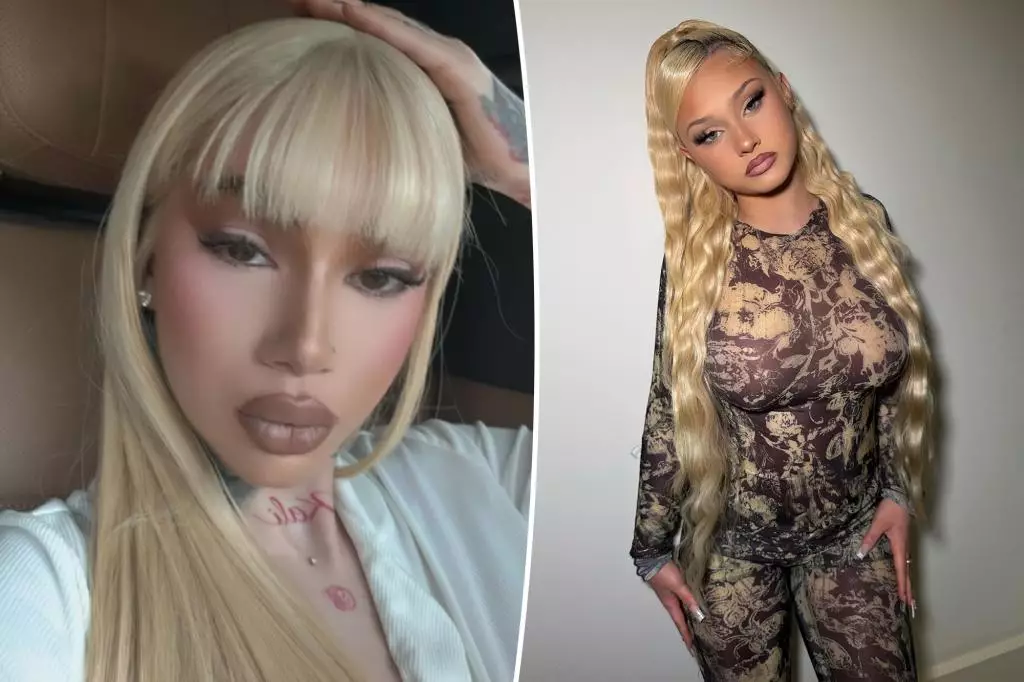In the ever-evolving world of social media, celebrity feuds have become a staple of public entertainment. Recently, the latest clash between Danielle Bregoli, better known as Bhad Bhabie, and Alabama Barker has captured the attention of fans and spectators alike. This ongoing feud, characterized by a blend of mockery and musical rivalry, has been marked by Bhabie’s recent bold transformation involving a platinum blond wig and significant makeup, seemingly styled to parody Alabama’s aesthetic.
Bhad Bhabie took to Instagram to showcase her striking new look, which not only included a blonde wig with bangs but also a noticeable cosmetic transformation. This appearance, coupled with her choice of attire—a classic white pajama set—was a strategic play, amplifying her diss track titled “Ms. Whitman,” directed towards Barker. Such choices are not mere whims; they are calculated moves designed to garner attention and further fuel the competitive narrative between the two.
Moreover, the moniker Bhad Bhabie chose for her track—referencing Patricia Arquette’s character Alabama Whitman from the classic film “True Romance”—adds a layer of depth to this performance art. By pulling in cinematic references, Bhabie showcases not just a personal rivalry, but an understanding of pop culture, portraying herself as a savvy player in the celebrity game.
With the upload of her video, fans quickly filled the comments, dissecting her appearance and pointing out the overt mockery aimed at Barker. Such response signifies not only the fans’ engagement in this feud but also hints at a broader trend within social media culture—where public figures often become characters in a narrative largely written by their audience. This dynamic raises important questions about authenticity in celebrity interactions; are these feuds truly reflective of personal tensions, or are they performed for publicity and profit?
Comments on Bhad Bhabie’s Instagram illustrate this phenomenon, with users explicitly noting the similarities in style and engaging in a playful analysis that highlights the entertainment value of the conflict. As fans rally to support their preferred side, they inadvertently contribute to the mythos surrounding these two young women, further entrenching their rivalry in popular culture.
This feud, while seemingly lighthearted on the surface, has deeper roots that intertwine with romantic entanglements and allegations of betrayal. Bhad Bhabie accused Alabama of vying for her ex-boyfriend, Le Vaughn, an accusation that sparked the initial discord. This led to a series of social media exchanges and ultimately, musical responses that have characterized their conflict. Alabama’s retort, boldly titled “Cry Bhabie,” further escalates the dramatics, showcasing the extent to which their interactions have been influenced by personal relationships.
In a landscape rich with instant communication and fleeting public perception, the Bhad Bhabie and Alabama Barker feud serves as a modern-day spectacle—drawing fans into a world where hairstyles, lyrics, and social media posts become weapons in a battle for fame and validation. As these two navigate the complexities of youth and celebrity, their rivalry encapsulates the intricate dance of personal dynamics and public personas in the digital age. What remains to be seen is how this feud will evolve as both women continue to craft their identities amidst the glare of the spotlight they both inhabit.

